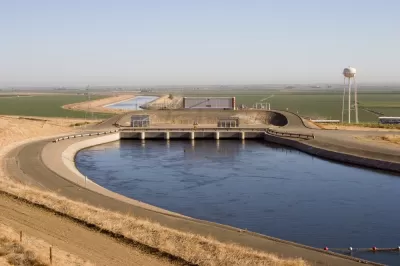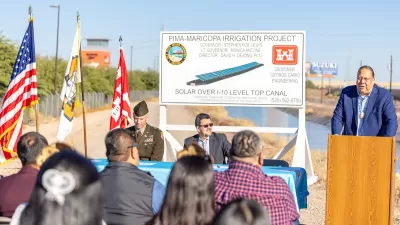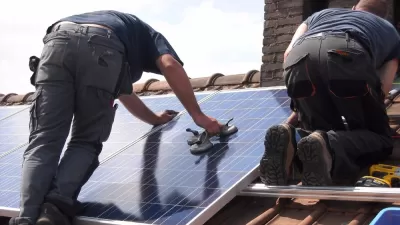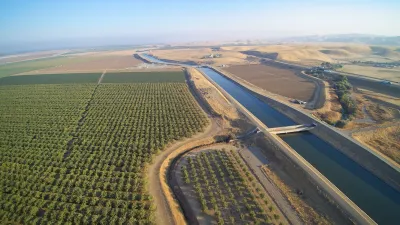Research claims that installing solar panels over California's extensive canals could greatly expand the state's renewable energy production and reduce evaporation.

A new study published in Nature Sustainability outlines the potential benefits of covering California's canals with solar panels, reports Matt Simon in High Country News. The study's results show that installing solar panels over 4,000 miles of California's waterways "would save 63 billion gallons of water from evaporating each year" and "provide 13 gigawatts of renewable power annually, about half of the new capacity the state needs to meet its decarbonization goals by the year 2030."
Doubling up on uses for the canals would provide a convenient solution for solar installations that would otherwise require the disturbance of natural habitats or farmland. Michael Kiparsky, director of the Wheeler Water Institute at the UC Berkeley School of Law, likens the idea to placing rooftop solar panels on a suburban home. "You’re taking something that's already been altered by human activity and doubling up on the benefits it provides."
Environmental engineer Brandi McKuin, lead author on the paper, said that "by covering canals with solar panels, we can reduce evaporation and avoid disturbing natural and working lands, while providing renewable energy and other co-benefits." The study's authors "also took into account the human benefits of such a project, which are more nebulous. For example, many farmers pump their water with diesel generators. If solar panels provided that energy instead, that could cut local emissions, thus improving air quality."
"Solar-paneling California’s canals could also prepare the state for the widespread adoption of electric cars. The California Aqueduct runs right along Interstate 5, the major artery carrying traffic between the northern and southern halves of the state. Where there are now gas stations dotted along the way, in the future there might be car-charging stations that draw power from the nearby aqueduct."
The study's authors recommend a demonstration project to evaluate the costs, benefits, and potential challenges associated with a full-scale implementation of the concept.
FULL STORY: Study looks at covering California’s canals with solar panels

Trump Administration Could Effectively End Housing Voucher Program
Federal officials are eyeing major cuts to the Section 8 program that helps millions of low-income households pay rent.

Planetizen Federal Action Tracker
A weekly monitor of how Trump’s orders and actions are impacting planners and planning in America.

Ken Jennings Launches Transit Web Series
The Jeopardy champ wants you to ride public transit.

Rebuilding Smarter: How LA County Is Guiding Fire-Ravaged Communities Toward Resilience
Los Angeles County is leading a coordinated effort to help fire-impacted communities rebuild with resilience by providing recovery resources, promoting fire-wise design, and aligning reconstruction with broader sustainability and climate goals.

When Borders Blur: Regional Collaboration in Action
As regional challenges outgrow city boundaries, “When Borders Blur” explores how cross-jurisdictional collaboration can drive smarter, more resilient urban planning, sharing real-world lessons from thriving partnerships across North America.

Philadelphia Is Expanding its Network of Roundabouts
Roundabouts are widely shown to decrease traffic speed, reduce congestion, and improve efficiency.
Urban Design for Planners 1: Software Tools
This six-course series explores essential urban design concepts using open source software and equips planners with the tools they need to participate fully in the urban design process.
Planning for Universal Design
Learn the tools for implementing Universal Design in planning regulations.
Ada County Highway District
Clanton & Associates, Inc.
Jessamine County Fiscal Court
Institute for Housing and Urban Development Studies (IHS)
City of Grandview
Harvard GSD Executive Education
Toledo-Lucas County Plan Commissions
Salt Lake City
NYU Wagner Graduate School of Public Service





























